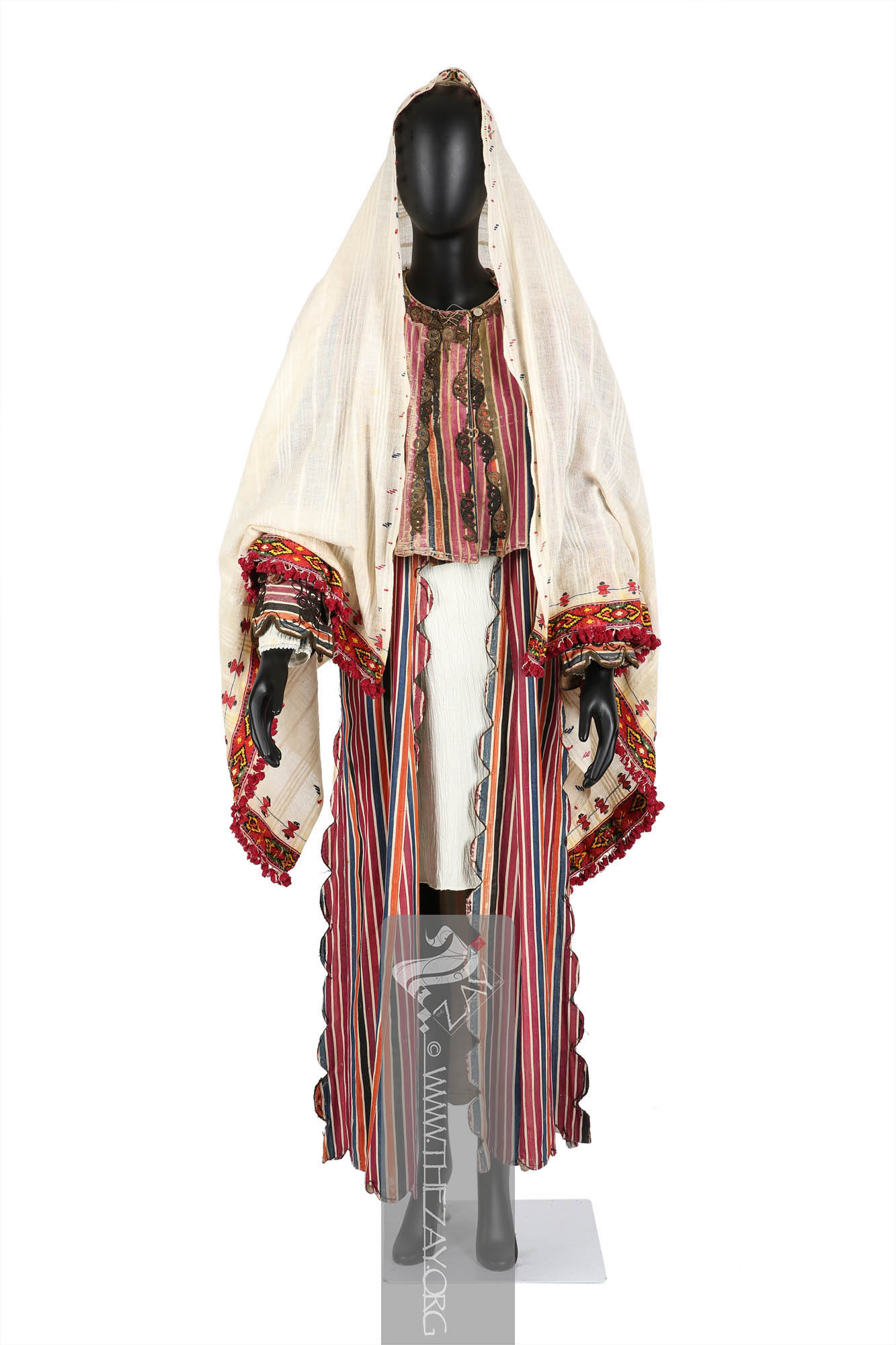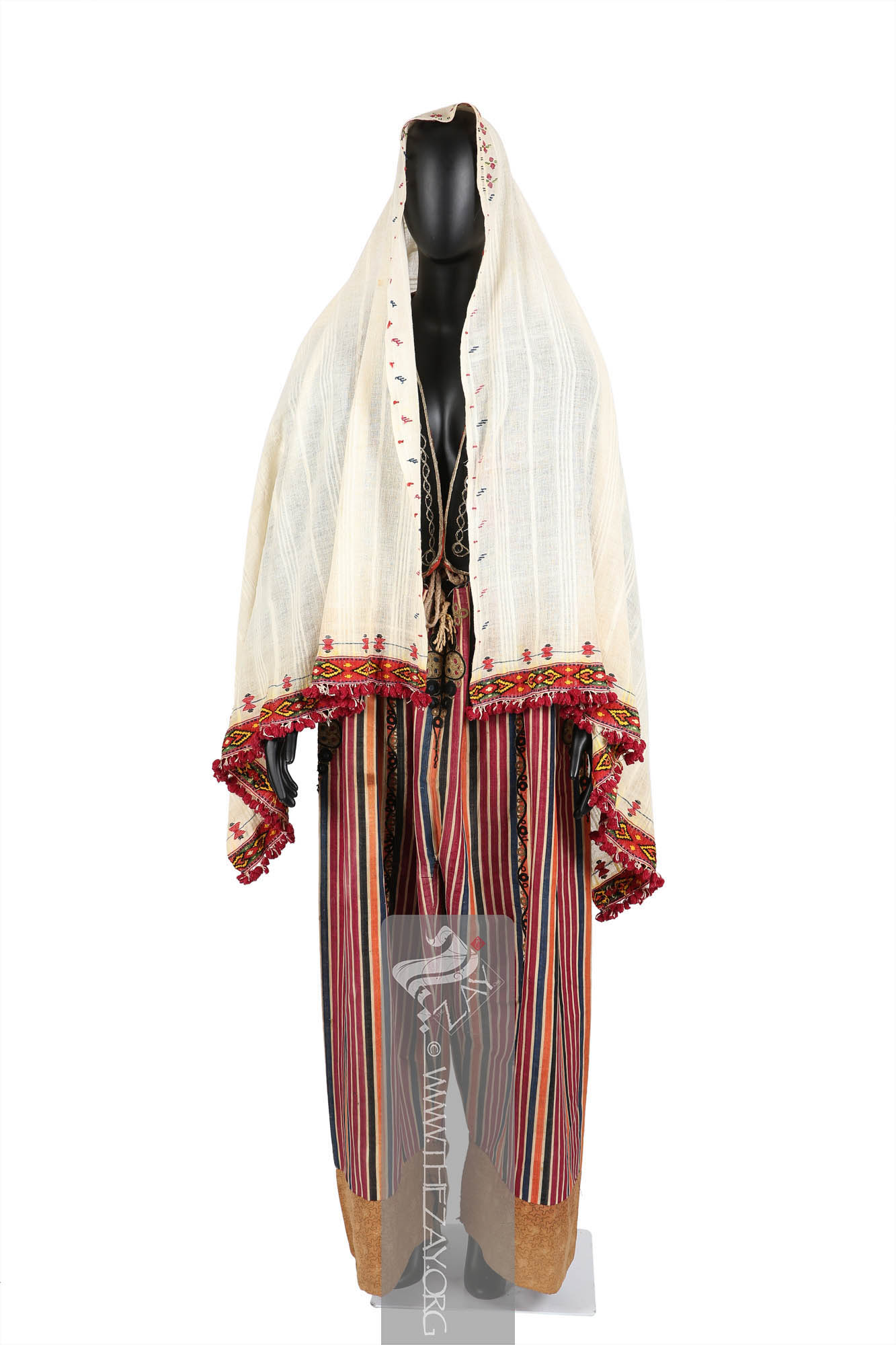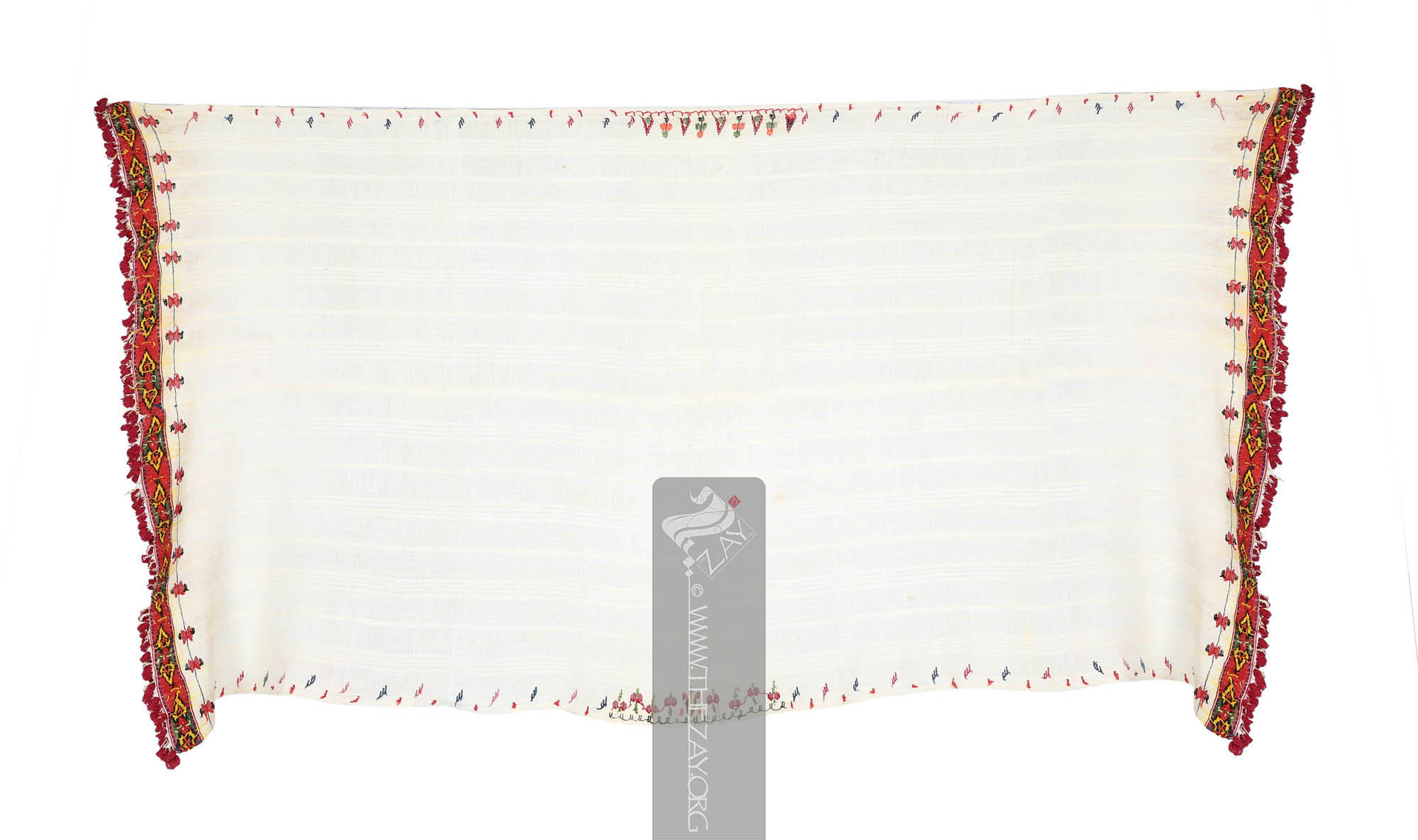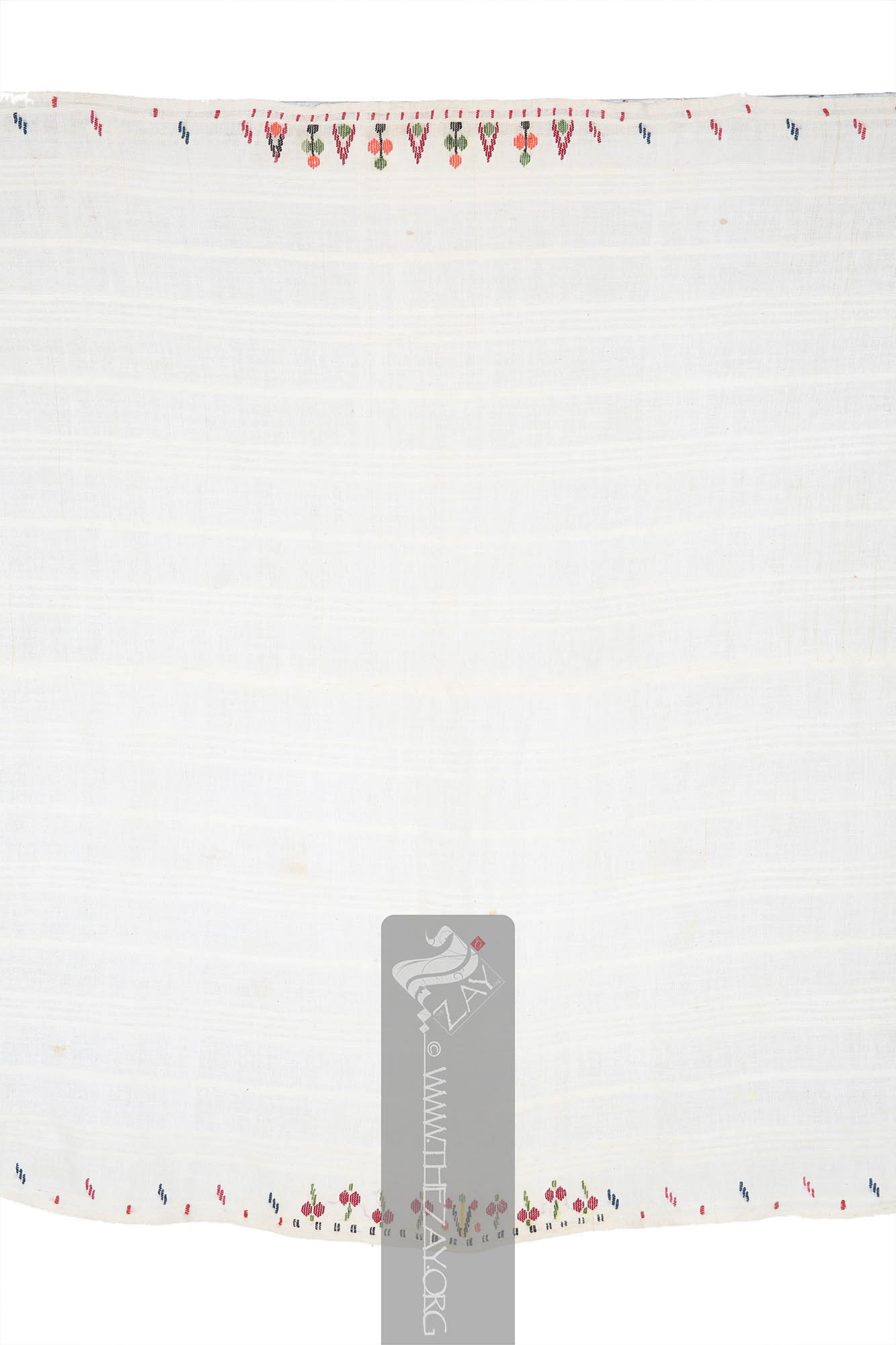Object NotePart of an ensemble with seven other pieces which are also part of the collection (
ZI2018.500640 ASIA,
ZI2018.500640a ASIA,
ZI2018.500640b ASIA,
ZI2018.500640c ASIA,
ZI2018.500640d ASIA, and
ZI2018.500640f ASIA).
Object History This piece of garment was purchased by
Dr. Reem Tariq
Ṭariq: (Arabic; Synonym: tulle_bi_talli
Tūlle_bi_tallī: (French: Tulle – a city in France where fine material for veil was first made; Turkish: tel – wire; Synonym: tariq; talli; badla; khus_dozi ), series of small metal knots made on a woven net ground as embellishment. The term is commonly used in the North African Arab region specifically in Egypt.
; talli; badla; khus_dozi ), series of small metal knots made on a woven net ground as embellishment. The term is commonly used in the Levant Arab region specifically in Lebanon.
El Mutwalli
Dr. Reem Tariq
Ṭariq: (Arabic; Synonym: tulle_bi_talli
Tūlle_bi_tallī: (French: Tulle – a city in France where fine material for veil was first made; Turkish: tel – wire; Synonym: tariq; talli; badla; khus_dozi ), series of small metal knots made on a woven net ground as embellishment. The term is commonly used in the North African Arab region specifically in Egypt.
; talli; badla; khus_dozi ), series of small metal knots made on a woven net ground as embellishment. The term is commonly used in the Levant Arab region specifically in Lebanon.
el Mutwallī: Founder (CEO) of the Zay
Zay: (Arabic: costume, Pl. azyaā’), a set of clothes in a style typical of a particular country or historical period. Initiative, a public figure, speaker and author. An expert curator and consultant in Islamic art and architecture, interior design, historic costume, and UAE heritage. as a set of ensembles from Jade Bréval, an independent collector from France in 2018 to add to and enhance The
Zay
Zay: (Arabic: costume, Pl. azyaā’), a set of clothes in a style typical of a particular country or historical period. Initiative collection.
Ms Jade Bréval who had travelled for over 15 years in and around Türkiye had collected items such as this from shops and individuals in small villages and towns that she visited.
Object Features This is an ivory cotton (
gauze
Gauze: (English), very fine wire mesh transparent fabric of silk, linen, or cotton.) rectangular head cover (
bash_bezi
Bash_bezi: (Turkish: bash – head; bez – cloth), a type of traditional headscarf commonly worn by women in the Ottoman empire. It is typically made of lightweight fabric and is wrapped around the head, covering the hair and neck. ) or veil (
peçe
Peçe: (Turkish), a traditional veil worn by women in the Ottoman empire. It typically consists of a sheer fabric, that covers the head as well as the entire face, if need be, to preserve privacy and modesty in public spaces. ) with (
selvedge
Selvedge: (English: Self-finished edge or self-edge: a dialect forming transition), an edge produced on woven fabric during manufacture that prevents it from unravelling. Traditionally the term selvage applied to only loom woven fabric, presently it could be applied to flat knitted fabric too. ) to
selvedge
Selvedge: (English: Self-finished edge or self-edge: a dialect forming transition), an edge produced on woven fabric during manufacture that prevents it from unravelling. Traditionally the term selvage applied to only loom woven fabric, presently it could be applied to flat knitted fabric too. weave. The (
weft
Weft: one of the two basic components used in weaving that transforms thread or yarns into a piece of fabric. It is the crosswise thread on a loom that is passed over and under the warp threads.) ends feature sporadic repeats of small line motifs in red and blue wool arranged alternately while the (
warp
Warp: One of the two basic components used in weaving which transforms thread or yarns to a piece of fabric. The warp is the set of yarns stretched longitudinally in place on a loom before the weft
Weft: one of the two basic components used in weaving that transforms thread or yarns into a piece of fabric. It is the crosswise thread on a loom that is passed over and under the warp threads. is introduced during the weaving process. ) ends feature a two-tier border.
The inner tier is composed of a line of repeats of geometric shapes in blue, black and red wool and the outer tier has a geometric design in flat
tapestry
Tapestry: wall hanging or other large piece of fabric that is woven in coloured weft
Weft: one of the two basic components used in weaving that transforms thread or yarns into a piece of fabric. It is the crosswise thread on a loom that is passed over and under the warp threads. threads or embroidered with a decorative design. Typically made of wool, but they can also be made of other materials such as silk, linen, or cotton. Often used to decorate homes, churches, and other buildings. style weave – famous for making (
kilim
Kilim: (Persian: Gilīm or galīm from Akkadian or Aramaic; Synonym: Plas), a traditional weaving technique with possible Central Asian origins. It involves tightly interlacing weft
Weft: one of the two basic components used in weaving that transforms thread or yarns into a piece of fabric. It is the crosswise thread on a loom that is passed over and under the warp threads. and warp
Warp: One of the two basic components used in weaving which transforms thread or yarns to a piece of fabric. The warp is the set of yarns stretched longitudinally in place on a loom before the weft
Weft: one of the two basic components used in weaving that transforms thread or yarns into a piece of fabric. It is the crosswise thread on a loom that is passed over and under the warp threads. is introduced during the weaving process. threads to create flat-woven geometric patterned rug and tapestry
Tapestry: wall hanging or other large piece of fabric that is woven in coloured weft
Weft: one of the two basic components used in weaving that transforms thread or yarns into a piece of fabric. It is the crosswise thread on a loom that is passed over and under the warp threads. threads or embroidered with a decorative design. Typically made of wool, but they can also be made of other materials such as silk, linen, or cotton. Often used to decorate homes, churches, and other buildings. fabrics in vibrant colours. It is widely popular across Central Asia, Iran, and Türkiye. ) carpets – with green, yellow, black, blue and orange wool over a red woollen background. The
warp
Warp: One of the two basic components used in weaving which transforms thread or yarns to a piece of fabric. The warp is the set of yarns stretched longitudinally in place on a loom before the weft
Weft: one of the two basic components used in weaving that transforms thread or yarns into a piece of fabric. It is the crosswise thread on a loom that is passed over and under the warp threads. is introduced during the weaving process. end edges have a series of red woollen pompoms attached to create a decorative fringe.
Unlike the typical square-shaped printed scarves (
yazma
Yazma: (Turkish), a lightweight, square-shaped Turkish traditional scarf made of cotton or silk and often adorned with vibrant printed, or hand drawn colourful patterns and delicate needle lace trimmings (oya). ) with needle lace (
oya
Oyā: (Turkish), refers to various forms of narrow needle lace trimmings common to eastern and southern Mediterranean regions and parts of Armenia. Believed to be a derivative of Venetian lace it is considered an indelible part of the traditional craft of Türkiye today. ) trimmings that are unique to Türkiye and is popular as a traditional headgear for covering the head, a
peçe
Peçe: (Turkish), a traditional veil worn by women in the Ottoman empire. It typically consists of a sheer fabric, that covers the head as well as the entire face, if need be, to preserve privacy and modesty in public spaces. covers both the head as well as the face of the wearer.
It is different from a (
yashmak
Yashmak: (Old Turkic yaş – to hide), a traditional face veil commonly used by women in the Turkmen and other Turkic society. It has different variants depending upon its geographical locations ranging from a thick veil made of horse to a thin lace veil covering the face with slits for the eyes. ) which is also a veil and is usually composed of two delicate (
muslin
Muslin: (Arabic: Mosul – A city in Iraq, or French: Mousse – Foam; Synonym: Mulmul; Melmel), a fine variety of plain-woven cotton unique to the Gangetic Delta – Ganges, Padma, and Meghna rivers. The term is either a derivative of Mosul, where it exchanged hands or "mousse" due to its lightweight and fluffy texture. ) pieces: one is tied below the nose, covering the face, while the other is draped over the forehead, encompassing the head.
Additionally, the name could differ from region to region even within Türkiye. While it is popularly known as a
yashmak
Yashmak: (Old Turkic yaş – to hide), a traditional face veil commonly used by women in the Turkmen and other Turkic society. It has different variants depending upon its geographical locations ranging from a thick veil made of horse to a thin lace veil covering the face with slits for the eyes. in certain regions it is also called a head cover or
bash_bezi
Bash_bezi: (Turkish: bash – head; bez – cloth), a type of traditional headscarf commonly worn by women in the Ottoman empire. It is typically made of lightweight fabric and is wrapped around the head, covering the hair and neck. in others.
Considering that this ensemble is of Balkan origin or influence it could be worn with a short pillbox hat unique to the north-western Marmara region of present-day Türkiye.
More InfoThe headdress played a significant role in traditional Turkish clothing, particularly for women. It often consisted of a hat that varied in shape, ranging from small and flat to very tall.
A
scarf
Scarf: (English), usually a rectangular piece of cloth loosely worn over the shoulders, upper body and arms, and sometimes also over the head. was wrapped around the head and hat, passing under the chin and tied either on top of the head or at the back of the neck. Married women would add a second
scarf
Scarf: (English), usually a rectangular piece of cloth loosely worn over the shoulders, upper body and arms, and sometimes also over the head. wrapped horizontally around the forehead, similar to a turban – a custom still practised amongst the Kurdish tribes.
However, these scarves were never used to cover their faces and it was never customary for Turkish women to use full veils. When leaving the house, women, however, would usually wear a large
scarf
Scarf: (English), usually a rectangular piece of cloth loosely worn over the shoulders, upper body and arms, and sometimes also over the head. that reached their elbows or feet to keep their hair covered.
The level of veiling depended on the conservatism of the family, with more conservative families opting for heavier veils. The scarves were often adorned with
oya
Oyā: (Turkish), refers to various forms of narrow needle lace trimmings common to eastern and southern Mediterranean regions and parts of Armenia. Believed to be a derivative of Venetian lace it is considered an indelible part of the traditional craft of Türkiye today. or other
crochet
Crochet: (French: croc - hook), a handicraft technique that involves using a hooked needle to create interlocking loops of yarn or thread to make a variety of items such as garments, accessories, and home decor. lace trimming in the form of three-dimensional flowers, leaves, or fruit, which conveyed information about the wearer's age, marital status, and affiliations. Silk or painted
yazma
Yazma: (Turkish), a lightweight, square-shaped Turkish traditional scarf made of cotton or silk and often adorned with vibrant printed, or hand drawn colourful patterns and delicate needle lace trimmings (oya). scarves were also exchanged as gifts during betrothals or weddings.
In the 19th century, Western influence began to shape women's fashion as they gradually became more involved in social life. Neighbourhoods like Pera in Istanbul became a fashion centre, following Parisian trends introduced by Greek and Armenian tailors.
During the reign of Abdülhamit II – 1876-1909 – cloaks were replaced by robes in the urban areas. However, rural areas maintained their traditional clothing styles. During the Republican era under Mustafa Kemal Atatürk – founding father and first president of the Republic of Türkiye, then Turkey – clothing norms that were so far influenced by religious reasons underwent a severe transformation.
The reforms implemented in 1925 had a significant impact in Türkiye, where traditional garments associated with Islamic customs, such as turbans and fezzes, were phased out.
As a result, people began adopting a more European style of clothing where men started wearing hats, jackets, shirts, waistcoats, trousers etc, women replaced the large scarves and veils or
peçe
Peçe: (Turkish), a traditional veil worn by women in the Ottoman empire. It typically consists of a sheer fabric, that covers the head as well as the entire face, if need be, to preserve privacy and modesty in public spaces. with coats, scarves, and shawls.
Nevertheless, even today women continue to incorporate various elements of traditional Turkish costume into their attire, especially during festivals and ceremonies.
Links
- Cangökçe, Hadiye, et al. Osmanlı İmparatorluğu’nun Son Döneminden Kadın Giysileri = Women’s Costume of the Late Ottoman Era from the Sadberk Hanım Museum Collection. Sadberk Hanım Museum, 2010.
- Küçükerman, Önder, and Joyce Matthews. The Industrial Heritage of Costume Design in Turkey. GSD Foreign Trade Co. Inc, 1996.
- AĞAÇ, Saliha, and Serap DENGİN. “The Investigation in Terms of Design Component of Ottoman Women Entari
: (Turkish; Synonym: Antari), a traditional Turkish long jacket-like unisex garment worn during the Ottoman era. It often featured an open front with long sleeves and was worn over an undershirt and a pair of trousers and was sometimes layered by a short waist or hip-length jacket. in 19th Century and Early 20th Century.” International Journal of Science Culture and Sport (IntJSCS), vol. 3, no. 1, Mar. 2015, pp. 113–125. https://dergipark.org.tr/tr/download/article-file/91778
- Parker, Julianne. “OTTOMAN AND EUROPEAN INFLUENCE IN THE NINTEENTH-CENTURY BRIDAL COLLECTION OF THE AZEM PALACE, DAMASCUS, SYRIA.” Journal of Undergraduate Research: Brigham Young University, 18 Sept. 2013. http://jur.byu.edu/?p=6014
- Koç, Adem. “The Significance and Compatibility of the Traditional Clothing-Finery Culture of Women in Kutahya in Terms of Sustainability.” Milli Folklor , vol. 12, no. 93, Apr. 2012. 184. https://www.millifolklor.com/PdfViewer.aspx?Sayi=93&Sayfa=181
- Micklewright, Nancy. “Late-Nineteenth-Century Ottoman Wedding Costumes as Indicators of Social Change.” Muqarnas, vol. 6, 1989, pp. 161–74. JSTOR, https://doi.org/10.2307/1602288. Accessed 13 July 2023.
- Micklewright, Nancy. “Looking at the Pst: Nineteenth Century Images of Constantinople and Historic Documents.” Expedition, vol. 32, no. 1, pp. 24–32. https://www.penn.museum/documents/publications/expedition/pdfs/32-1/micklewright.pdf
- Ozgen, Ozlen, et al. “Henna Ritual Clothing in Anatolia from Past to Present: An Evaluation on Bindalli.” Textile Society of America Symposium Proceedings, 2021, https://doi.org/10.32873/unl.dc.tsasp.0122.
- https://babogenglish.wordpress.com/2016/02/25/turkey-general-information/
- https://www.issendai.com/16thcenturyistanbul/womens-garb-piece-by-piece/arakiyye-and-all-the-trimmings-hat-veil-hatband-scarves/
- https://www.issendai.com/16thcenturyistanbul/garments/what-did-they-look-like/headgear/narrow-fabric-wound-around-a-womans-hat/








